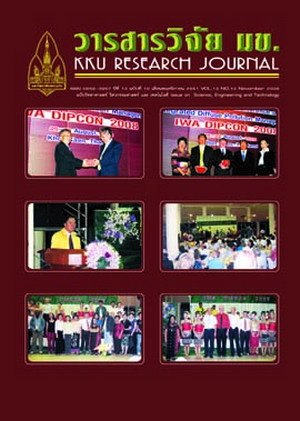Community forest: a local attempt in natural resource management, economic value of ecosystem services, and contribution to local livelihoods
Main Article Content
Abstract
This survey-based research investigates current forest management at Khoa noi-Napang Community Forest, the 2004 Khon Kaen Province's best community forest. The study also analyzes forest structure and estimates economic value of non-timber forest product (NTFP) collection. Currently, harvesting of trees is prohibited, while NTFP collection remains open access. Eighty species (35 families) of trees were identified of which the three most important species are Shorea obtusa Wall. ex. Blume, Dipterocarpus tuberculatus Roxb. and Memecylon scutellatum Naudin (importance value index = 41.18%, 38.84% and 23.39% respectively). Twenty four NTFPs, classified into seven groups were reported being harvested by villagers. Net economic value of direct benefits derived from NTFPs is approximately US$26,462 or US$141 per household in 2007, accounted for 23.64% of an average annual household income. This value represents approximately US$47 per Rai, while an average net benefit from rice growing is roughly US$ 12-21 per Rai. Finally, the forest is observed by villagers that its conditions are much improved within 25 years of management. This reveals that local community can play a key role in natural resource management, which in return helps support local livelihoods. Keywords: community forest, economic valuation,
Article Details
How to Cite
Pagdee, A., Homchuen, S., Sang-arome, P., & Sasaki, Y. (2017). Community forest: a local attempt in natural resource management, economic value of ecosystem services, and contribution to local livelihoods. Asia-Pacific Journal of Science and Technology, 13(10), 1129–1134. retrieved from https://so01.tci-thaijo.org/index.php/APST/article/view/83500
Section
Research Articles


